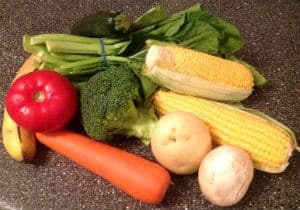
Can your student’s identify these plant structures?
This one seems like a simple task to run with your students but you might be surprised about the results. Next time you’re planning on running a basic plant anatomy class with your students, why not pop down to the shops and pick up some grocery items from the fruit and vegetable aisle to test them with? You’d expect that people should be able to quickly work out if they’re looking at a seed, an inflorescence, a stem, berry, fruit, tuber or root but actually it can be a little tricky… especially if the terminology used at home and in general conversation is filled with misnomers.
Recently I was running an after school science program for students in a Sydney library. As a quick introduction to the structure of plants I had a pile of common fruits and vegetables on the presenting desk and got kids to vote on each item as to what it was. The possible choices were a seed, a tuber, a fruit, a root, a berry, an inflorescence, a “vegetable” or a stem. No definition was given for each item as I just wanted to survey the class to see where they thought. The following table gives the class spread of results:
Tomato 60% fruit, 20% berry, 20% vegetable, 5% seed and 5 % unsure…..(Answer = berry)
Potato 85% root, 15% tuber…. (Answer = tuber)
Corn kernel 80% fruit, 10% berry, 10% seed (Answer = seed)
Broccoli 80% inflorescence, 15% stem, 5% seed (Answer = inflorescence)
Banana 95% fruit, 5% seed (Answer = berry)
Carrot 80% root, 15% tuber, 5% unsure (Answer = root)
Cabbage 85% leaf, 15% flower (Answer = leaf)
Celery 95% stem, 5% leaf (Answer = stem)
As you can see form above, the class did pretty well but there definitely was some confusion, especially with the Banana, the Corn Kernel and the Tomato. Of course, as we progressed through the items the kids started to pick up on the similarities between each of the items and were swayed by other more vocal opinions in the group but it was interesting that not one of the items got 100% of the class to make the right call.
Of course, the difficulty in the task above lies in how you define each plant part (this varies from source to source of course!). The main problem that could be identified was in working out the fuzzy notion of what constitutes a “fruit” as botanically there are several types of fruit. As a fruit is an organ that contains and protects seeds you could pop tomatoes in either the “fruit” or the “berry” category in this activity and you could argue that both answers are right… until you find out that fruit is the broad category and that a berry is a much more defined structure in botany which covers the tomato much more closely. This makes the definition of a banana as a berry quite strange to students and caused quite some contention in the group. Interestingly the students also struggled to define a potato as a tuber as opposed to a root… this was due to some of them not knowing that the word “tuber” and others trying to second-guess the quiz!
The issue is that if kids are not exposed to the correct biological language from outside the classroom they’re going to bring a variety of preconceptions into your biology class that you need to address. I know I grew up thinking that a tomato was a vegetable as it went into salad, you might find that many of your kids will think the same thing. In fact, I’d challenge you to run the same test with some adults! So to help out, here are some simple definitions that might help your next class on plant anatomy. Of course it would be wise to consult an up to date biological description as every now and then as the definitions change.
- seed
An encapsulated plant embryo; a fertilized ovule of a plant.
- tuber
A swollen, fleshy, usually underground outgrowth of the stem or rhizome of a plant bearing buds from which new plant shoots arise
- root
An underground portion of a plant that lacks buds, leaves, or nodes and serves as support, draws minerals and water from the surrounding soil, and sometimes stores food.
- fruit
The botanical definition of a fruit is an organ that contains seeds, protecting these as they develop and often aiding in their dispersal.
- stem
The stem is the stalk of a plant or the main trunk of a tree, in that it is the main plant axis that bears buds and shoots with leaves and at its base it leads into the roots.
- berry
A berry is a fleshy fruit without a stone produced from a single flower containing one ovary and typically have several seeds.
- flower
A reproductive structure in angiosperms (flowering plants), often conspicuously colourful and typically including sepals, petals, and either or both stamens and/or a pistil.
If you really want to get them thinking, why not introduce the words ‘drupe’, ‘nut’, ‘petiole’ and more… but perhaps baby steps first? All the best!























Comments